Imagine having a revolutionary idea that could disrupt an entire industry. You’ve done the hard work, perfected the concept, and now it’s time to pitch it to potential investors.
But instead of enthusiastic nods and immediate interest, you’re met with polite smiles and vague promises of future contact.
What went wrong?
Often, it’s not the idea that falls short but how it’s presented, particularly during those critical first moments—the elevator pitch slide.
I’m Viktor, a pitch deck expert, and a presentation expert. Over the past 13 years, I’ve helped businesses secure millions of $ in funding thanks to my approach and I’m sharing it here in this pitch deck guide.
In this guide, I’m going to show you how to craft an elevator pitch slide that not only captures attention but leaves investors eager to hear more. We’ll break down what makes a pitch slide pop, dissect common mistakes, and even turn cringe-worthy pitches into success stories.
Book a free personalized pitch deck consultation and save over 20 hours of your time.
Join hundreds of successful entrepreneurs who’ve transformed their pitch decks with my help.
Let me develop an investor ready deck by using my hands-off approach, which includes: market research, copy, design, financials, narrative and strategy.
One week turnaround time.
The least you will get is 10 actionable tips & strategies to own that next presentation, worth $599, for free.

What Is An Elevator Pitch Slide?
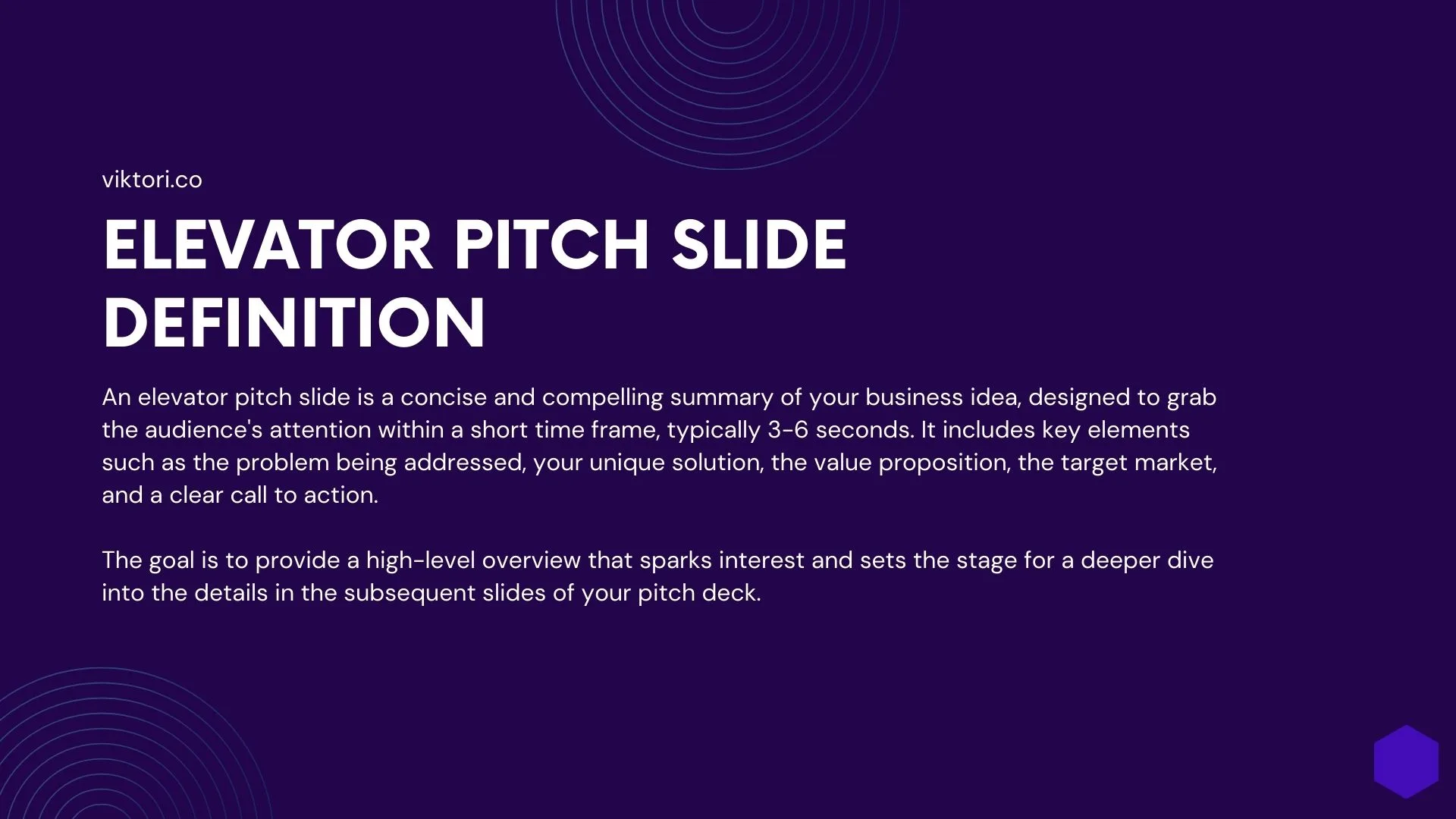
An elevator pitch slide is a brief, persuasive slide that you use to spark interest in what your organization does. It should be succinct enough to deliver in the time span of an elevator ride, typically about 3 to 6 seconds.
The purpose of the elevator pitch slide is to quickly convey the essence of your business idea, highlighting the problem you are solving, your unique solution, and the value proposition that sets you apart from competitors.
It’s about distilling your entire business concept into a single engaging sentence that pique curiosity and prompt further discussion.
How Important Is The Elevator Pitch Slide For Your Pitch Deck?
The elevator pitch is the backbone of your pitch deck. It’s the hook that grabs your audience’s attention, the concise summary that distills your idea into a few compelling sentences.
Most importantly, it sets the mindset frame in which all of your audience will spend then next 5-10 minutes thinking and analyzing your pitch.
Research by Princeton psychologists Janine Willis and Alexander Todorov has shown that it takes only a tenth of a second for people to form an impression of a stranger from their face, and while your pitch isn’t about your face, the principle still applies. In the context of a pitch deck, the elevator pitch is your opportunity to make that crucial first impression count. A strong, well-crafted elevator pitch can set the stage for a successful pitch meeting, while a weak one can doom your efforts from the start.
This slide is your way of setting up control for the rest of the pitch length.
Examples of Successful Companies with Great Elevator Pitches
Several successful companies have demonstrated the power of an effective elevator pitch, leveraging it to secure crucial funding and support in their early stages. Here are a few notable examples:
- Airbnb: Airbnb’s elevator pitch effectively captured the essence of their disruptive business model. It went something like this: “Airbnb is a platform that allows people to rent out their spare rooms or homes to travelers looking for affordable and unique accommodations.” This pitch clearly communicated the problem (expensive and impersonal hotel accommodations), the solution (affordable, unique lodging options), and the value proposition (a more personalized travel experience).
- Dropbox: Dropbox’s elevator pitch succinctly conveyed their value proposition: “Dropbox is a service that lets you bring all your photos, docs, and videos anywhere and share them easily.” This pitch highlighted the problem (difficulty in accessing and sharing files across devices), the solution (a seamless file-sharing service), and the value proposition (easy access and sharing).
- Uber: Uber’s elevator pitch was straightforward and impactful: “Uber is an app that connects passengers with drivers for hire.” This pitch identified the problem (the inefficiency of traditional taxi services), the solution (an on-demand ride-hailing app), and the value proposition (convenient, reliable transportation).
Each of these examples demonstrates the power of a clear, concise, and compelling elevator pitch in capturing investor interest and setting the stage for successful funding rounds. By distilling their complex business models into simple, engaging narratives, these companies were able to quickly convey their unique value propositions and secure the support they needed to grow.
The Effect An Elevator Pitch Has On The Other Slides
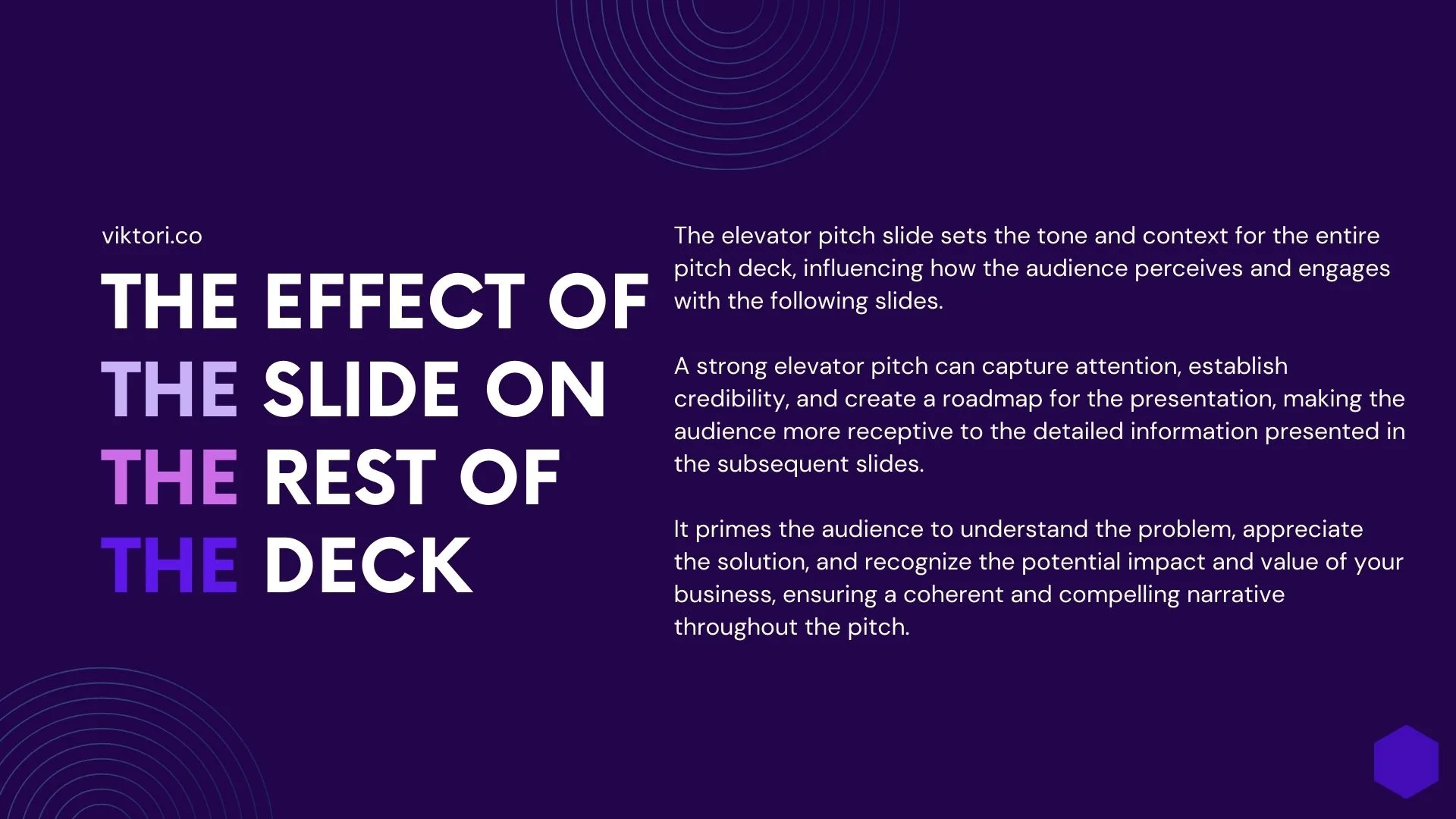
| Slide | Impact of the Elevator Pitch Slide |
|---|---|
| 1. Title Slide | Sets the expectation and tone for the rest of the deck. The title slide should be aligned with the concise, compelling message introduced in the elevator pitch. |
| 2. Elevator Pitch Slide | Establishes the core message, problem, solution, and value proposition. Provides a roadmap for the rest of the presentation. |
| 3. Problem Statement | Builds on the problem identified in the elevator pitch, providing detailed context and evidence. A clear problem in the elevator pitch primes the audience to understand the depth and impact of the problem here. |
| 4. Solution | Expands on the solution briefly introduced in the elevator pitch, detailing how it works and why it’s effective. The audience is already curious about the solution due to the elevator pitch. |
| 5. Market Opportunity | Provides detailed market analysis and potential, leveraging the initial interest sparked by the elevator pitch about the target market. The elevator pitch’s overview of the target market sets the stage for deeper insights here. |
| 6. Business Model | Explains how the business will make money, building on the value proposition highlighted in the elevator pitch. The clarity of the elevator pitch ensures that the business model is understood in context. |
| 7. Product/Service | Showcases the product or service in detail, supported by the initial solution description in the elevator pitch. The elevator pitch primes the audience for a deeper dive into the product/service features and benefits. |
| 8. Traction | Demonstrates early success and user adoption, building credibility started in the elevator pitch. The initial confidence built by the elevator pitch ensures that traction is viewed as a logical progression. |
| 9. Marketing Strategy | Details the plan to attract and retain customers, expanding on the market reach suggested in the elevator pitch. The elevator pitch’s concise market introduction helps the audience appreciate the strategy’s scope and potential effectiveness. |
| 10. Financials | Presents financial projections and funding requirements, contextualized by the elevator pitch’s value proposition and market potential. The initial interest in the elevator pitch supports a positive reception of financial viability. |
| 11. Team | Highlights the team’s expertise and ability to execute, reinforcing the credibility initiated by the elevator pitch. The elevator pitch’s effective communication suggests a capable team behind the venture. |
| 12. Roadmap | Outlines future milestones and goals, aligned with the vision introduced in the elevator pitch. The elevator pitch’s compelling vision encourages the audience to believe in the feasibility of the roadmap. |
| 13. Conclusion/Call to Action | Wraps up the presentation with a strong call to action, echoing the elevator pitch’s initial call to action. The elevator pitch sets the expectation for a decisive and engaging conclusion, reinforcing the need for immediate follow-up. |
This table outlines how each subsequent slide in the pitch deck is influenced by the clarity, conciseness, and compelling nature of the elevator pitch slide. The elevator pitch primes the audience, ensuring that each detailed aspect of the business is received within the context established at the beginning.
Key Components of an Effective Elevator Pitch Slide
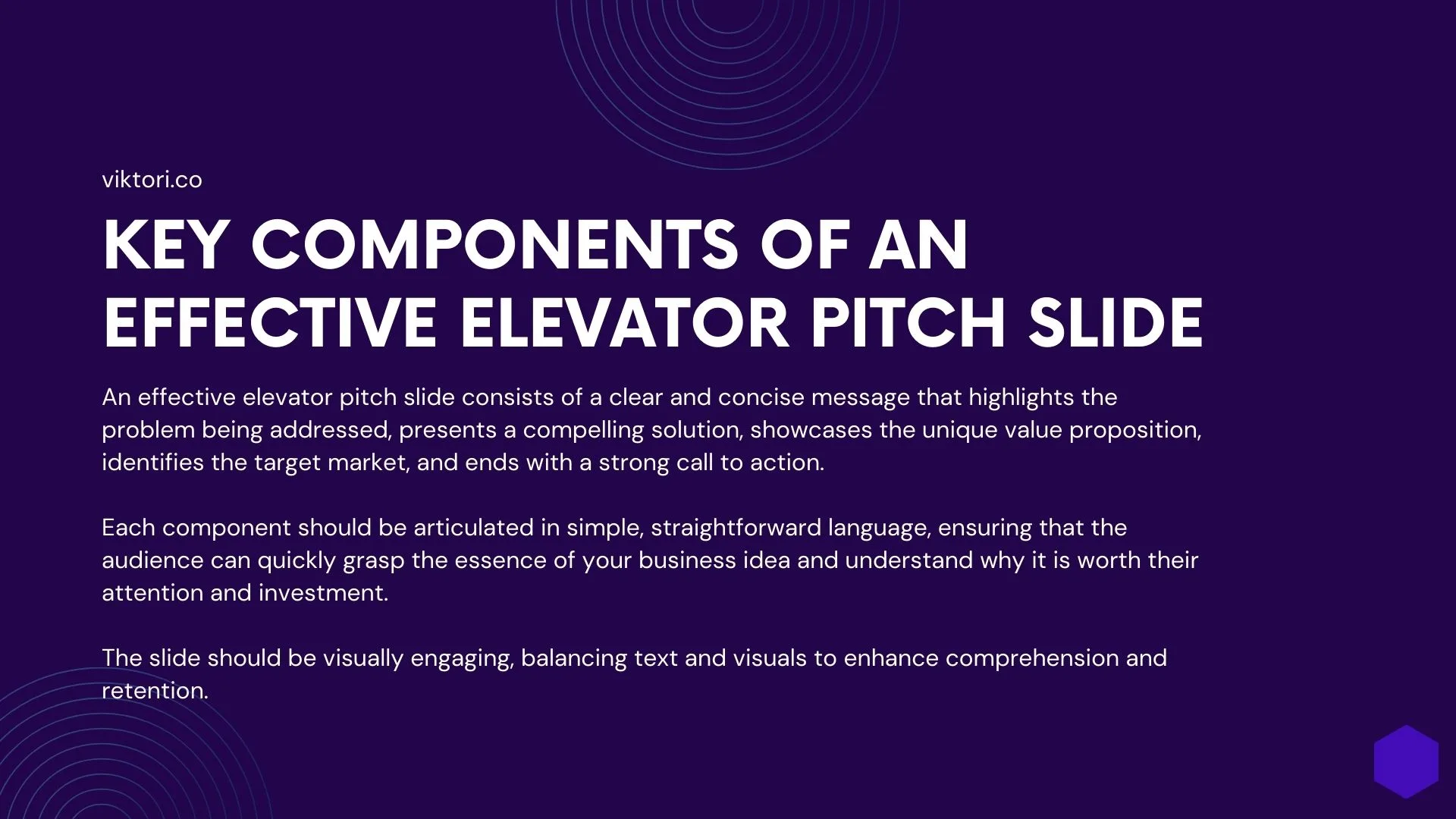
Creating an effective elevator pitch slide is all about distilling your business idea into a few powerful elements that quickly convey the essence of your venture. Here are the key components:
Clear and Concise Message
In just 1 to 2 sentences, you should be able to convey the core of your business idea in a way that’s easy to understand and remember. Avoid jargon and complex language; instead, focus on clarity and simplicity.
The goal is to ensure that anyone, regardless of their background, can grasp what your business does and why it matters. A clear and concise message sets the stage for the rest of your pitch, making it easier for your audience to follow along and stay engaged.
Highlighting the Problem and Solution
Identifying the problem your business aims to solve is crucial. This helps establish the relevance and necessity of your solution. Clearly articulate the pain point or challenge faced by your target market. Following the problem, immediately present your solution. Explain how your product or service effectively addresses the identified problem.
This combination of problem and solution forms the backbone of your elevator pitch, demonstrating that your business is not just a good idea, but a necessary one. For instance, Airbnb’s pitch highlighted the problem of expensive and impersonal hotel accommodations and presented their solution of affordable, unique lodging options through a shared economy model.
Unique Value Proposition
Your unique value proposition (UVP) sets you apart from competitors. It’s a statement that explains why your solution is better and why customers should choose you. Your UVP should be compelling and highlight the distinct advantages of your product or service. This could include unique features, innovative technology, superior quality, cost-effectiveness, or exceptional customer service. The UVP is your opportunity to showcase what makes your business special and why it stands out in the marketplace. For example, Dropbox’s UVP was its simplicity and ease of use for file storage and sharing, making it an appealing choice over more complex alternatives.
Target Market and Potential Impact
Identifying your target market shows that you have a clear understanding of who your customers are and the specific needs your business addresses. Outline the demographics, behaviors, and preferences of your ideal customer. This not only demonstrates market research but also helps investors understand the scope and potential reach of your business. Additionally, discuss the potential impact of your solution on this market. Highlighting market size, growth potential, and customer demand can strengthen your pitch by showing that there is a significant opportunity for your business to thrive. For instance, Uber effectively communicated its target market by emphasizing the broad need for reliable, on-demand transportation in urban areas.
Call to Action
A compelling call to action (CTA) is essential to wrap up your elevator pitch. It should clearly state what you want from your audience, whether it’s investment, partnership, feedback, or another form of engagement. Your CTA should be direct and persuasive, leaving no doubt about the next steps you want the audience to take. For example, you might end with, “We’re seeking $1 million in seed funding to expand our operations and reach new markets. Join us in revolutionizing the transportation industry.” This approach gives your audience a clear path to follow and emphasizes the urgency and importance of your request.
The Elevator Pitch Slide Formula
Wrapping it all into one:
We help {x target} achieve {y result} with the help of {z solution}.
Simple as that.
By integrating these key components, you can craft an elevator pitch slide that is not only informative but also engaging and persuasive. Each element works together to build a narrative that captures attention, communicates value, and motivates your audience to take action.
Designing the Elevator Pitch Slide
Designing the elevator pitch slide is about creating a visually compelling and easy-to-digest presentation that enhances your message. Here’s how to do it effectively:
Visual Elements that Enhance the Message
- Graphics and Icons: Use relevant graphics and icons to represent key points visually. These elements can help simplify complex ideas and make your slide more engaging. For example, if your solution involves technology, using icons for devices or networks can quickly convey this aspect of your business.
- High-Quality Images: Use high-resolution images that are relevant to your business or product. Images can evoke emotions and help your audience connect with your pitch on a personal level. For example, an image of happy customers using your product can make your solution more relatable and desirable.
- Color Scheme: Choose a color scheme that aligns with your brand and creates a cohesive look. Colors can also be used to highlight key points and guide the audience’s attention. Be mindful of color psychology; for example, blue can evoke trust, while green is often associated with growth and innovation.
The Balance Between Text and Visuals
- Minimal Text: Keep text to a minimum. Use bullet points or short sentences to convey your message. Overloading the slide with text can overwhelm the audience and detract from the visual impact. Aim for brevity and clarity, ensuring that each word counts.
- Complementary Visuals: Ensure that visuals complement the text and not just fill space. Each graphic, icon, or image should serve a purpose and enhance the understanding of the content. For example, if you mention a significant market opportunity, a simple bar graph can underscore this point effectively.
- Readable Fonts: Use large, readable fonts that are easy to see from a distance. Sans-serif fonts like Arial or Helvetica are often preferred for presentations due to their clarity. Avoid overly decorative fonts that might distract from the message.
- Consistent Layout: Maintain a consistent layout throughout the slide to create a professional look. Align text and visuals neatly, and use white space effectively to avoid clutter. Consistency helps in maintaining focus and makes the slide more aesthetically pleasing.
Tips for Creating a Visually Appealing and Impactful Slide
- Focus on One Main Idea: Each slide should focus on one main idea to avoid overwhelming the audience. For the elevator pitch slide, this main idea is the core message of your business. Ensure that every element on the slide contributes to this central theme.
- Use Contrasting Colors: Use contrasting colors to make important information stand out. For example, a bold color for the call to action can draw the audience’s eye to the next steps you want them to take.
- Keep It Simple: Simplicity is key in design. Avoid unnecessary elements that do not add value to your message. A clean and straightforward design helps the audience focus on the content.
- Test Your Slide: Before presenting, test your slide with a small audience to get feedback on its clarity and impact. Make adjustments based on this feedback to ensure that your final slide is as effective as possible.
- Use Professional Design Tools: Leverage professional design tools like Canva, PowerPoint, or Keynote to create polished and visually appealing slides. These tools offer templates and design elements that can enhance your presentation.
By focusing on these design principles, you can create an elevator pitch slide that not only communicates your message effectively but also engages and impresses your audience. A well-designed slide can significantly enhance the overall impact of your pitch, making it more memorable and persuasive.
Common Mistakes in Elevator Pitch Slides
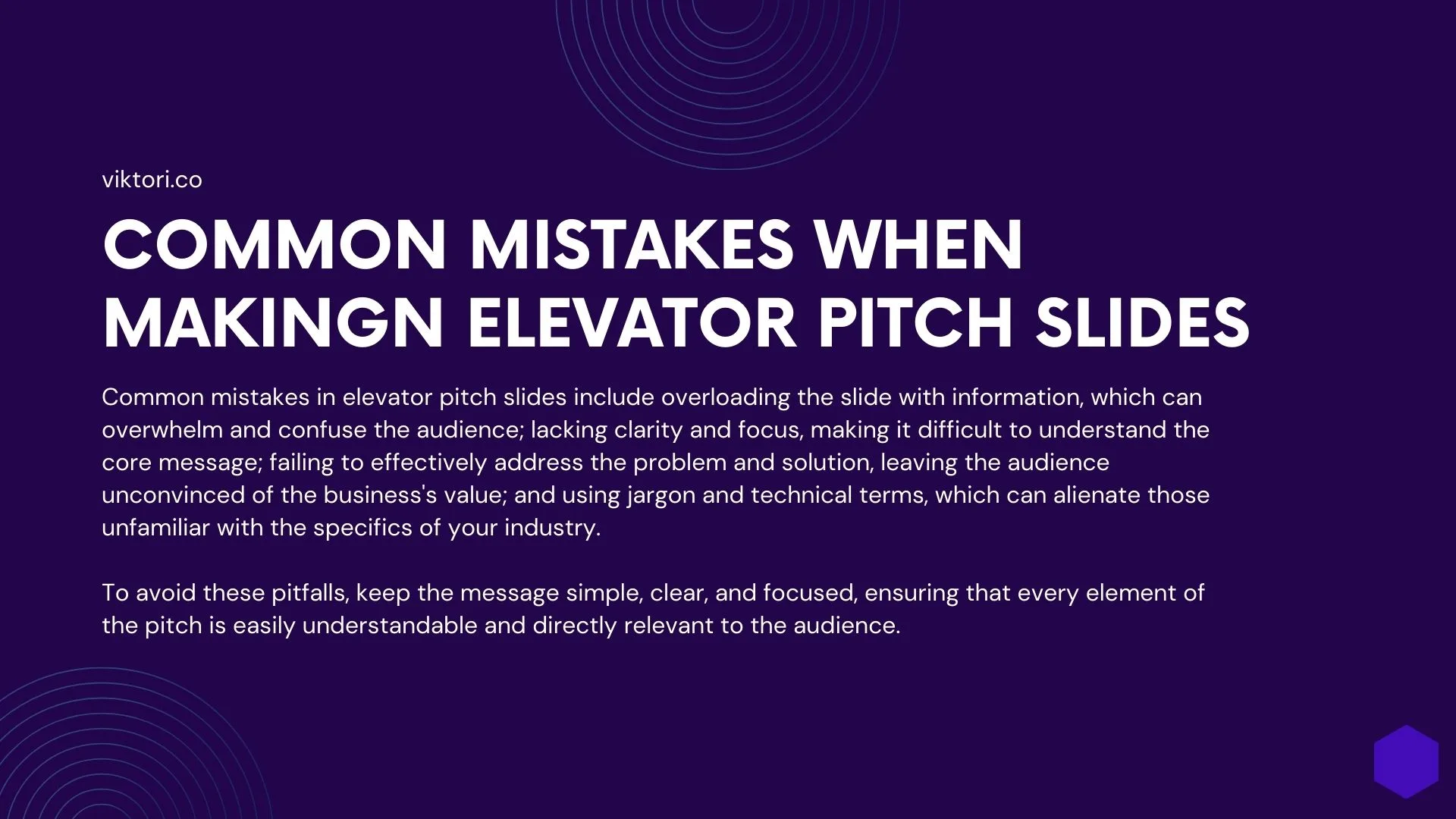
Crafting an effective elevator pitch slide requires precision and attention to detail. However, even with the best intentions, certain common mistakes can undermine the impact of your pitch. Here are some pitfalls to avoid:
Overloading with Information
- Too Much Text: Packing your slide with text can overwhelm your audience and dilute your message. Instead of trying to explain every detail, focus on the most critical points. Remember, the elevator pitch is meant to be a concise summary, not a comprehensive overview.
- Excessive Data: Including too many statistics or data points can confuse rather than clarify. Choose the most impactful data that directly supports your main message. Use visuals like charts or graphs to present this data succinctly.
- Cluttered Design: A cluttered slide with too many elements—images, icons, charts—can distract from the core message. Maintain a clean, organized layout to ensure that your key points stand out.
Lack of Clarity and Focus
- Vague Messaging: An elevator pitch must be clear and to the point. Avoid vague statements and ensure that your message is direct and easily understood. Clearly define your business idea, the problem it solves, and the value it offers.
- Unclear Value Proposition: Your value proposition should be the highlight of your pitch. If it’s not immediately clear why your solution is unique and valuable, the audience may lose interest. Be explicit about what sets your business apart from competitors.
- Inconsistent Storytelling: A disjointed narrative can confuse your audience. Ensure that your pitch flows logically from the problem to the solution and finally to the value proposition. Consistent storytelling helps in maintaining engagement and understanding.
Failing to Address the Problem and Solution Effectively
- Ignoring the Problem: If you don’t clearly articulate the problem your business addresses, the audience may not see the relevance of your solution. Start with a compelling problem statement that resonates with your target market.
- Weak Solution Explanation: A vague or overly complex description of your solution can leave the audience puzzled. Make sure your solution is described in simple terms that clearly demonstrate how it addresses the problem.
- No Real-World Context: Providing examples or scenarios that illustrate the problem and solution in action can make your pitch more relatable and convincing. Real-world context helps the audience visualize the impact of your solution.
Using Jargon and Technical Terms
- Complex Language: Using industry jargon or technical terms can alienate audience members who are not familiar with the specifics of your field. Opt for simple, everyday language that anyone can understand.
- Assuming Prior Knowledge: Don’t assume that your audience has prior knowledge of your industry or technology. Explain concepts in a way that is accessible to everyone, ensuring that your pitch is inclusive and comprehensible.
- Overly Technical Explanations: While it’s important to show that you understand the technical aspects of your business, overly technical explanations can bog down your pitch. Focus on the benefits and outcomes rather than the intricate details.
Tips to Avoid These Mistakes
- Practice Simplicity: Strive for simplicity in both your content and design. A clear and straightforward slide will be more effective than one that tries to cover too much ground.
- Get Feedback: Present your elevator pitch slide to colleagues or mentors and ask for honest feedback. They can help identify areas where you might be overloading information or lacking clarity.
- Refine Your Message: Continuously refine your message to ensure that it remains focused and impactful. Edit ruthlessly to remove any unnecessary information or elements.
- Test for Understanding: Test your slide with people outside your industry to see if they can understand and relay your pitch back to you. If they struggle, it’s a sign that you need to simplify and clarify further.
How To Write An Elevator Pitch: Template and Steps to Create It
Crafting an elevator pitch can be daunting, but with a structured approach, you can create a compelling and concise pitch that effectively conveys your business idea. In this section, we’ll provide a detailed template and step-by-step guide to help you create an impactful elevator pitch.
The Goal: We help {x target} achieve {y result} with the help of {z solution}.
Here’s a basic template to get you started:
- Introduction: Briefly introduce yourself and your business.
- Problem Statement: Clearly articulate the problem your business addresses.
- Solution: Explain your solution and how it effectively solves the problem.
- Unique Value Proposition (UVP): Highlight what makes your solution unique and valuable.
- Target Market: Define who your customers are and the market you’re targeting.
- Call to Action (CTA): End with a compelling call to action, specifying what you want from your audience.
Step-by-Step Guide on Crafting Each Part of the Elevator Pitch Slide
- Identifying the Problem
- Step 1: Research and understand the pain points of your target market. What are the common challenges or issues they face?
- Step 2: Articulate the problem in a clear and relatable way. Make sure it resonates with your audience and highlights the urgency or importance of solving it.
- Example: “Small businesses often struggle with managing their social media presence effectively, leading to missed opportunities and reduced customer engagement.”
- Presenting the Solution
- Step 1: Describe your solution succinctly. Focus on how it addresses the problem directly.
- Step 2: Highlight any innovative aspects or unique features that set your solution apart from others.
- Example: “Our platform, SocialHub, automates social media management, allowing businesses to schedule posts, analyze performance, and engage with customers effortlessly.”
- Highlighting the Unique Value Proposition (UVP)
- Step 1: Identify what makes your solution unique. This could be a specific feature, a novel approach, or a competitive advantage.
- Step 2: Clearly articulate the benefits your solution provides and why it’s better than existing alternatives.
- Example: “Unlike other tools, SocialHub uses AI to provide personalized content suggestions, ensuring that every post maximizes engagement and reaches the right audience.”
- Defining the Target Market
- Step 1: Define who your ideal customers are. Consider demographics, behaviors, and preferences.
- Step 2: Explain why your solution is perfectly suited for this market.
- Example: “Our primary target market is small to medium-sized businesses looking to enhance their social media presence without the need for a dedicated marketing team.”
- Crafting a Compelling Call to Action (CTA)
- Step 1: Decide on the specific action you want your audience to take, whether it’s scheduling a meeting, investing, or signing up for a trial.
- Step 2: Make your CTA clear, direct, and persuasive.
- Example: “We’re seeking $500,000 in seed funding to expand our platform and reach more businesses. Join us in revolutionizing social media management for small businesses.”
Looks long? It should be. What you need to do next is cut the content down in half. Just like a proffesional sculptor, what you need to do is cut out all the information the elevator pitch slide can live without and get to the ideal format:
We help {x target} achieve {y result} with the help of {z solution}.
22 Bad Elevator Pitch Examples Turned Great
In this section, we’ll explore 22 real-life examples of bad elevator pitches that were transformed into compelling and effective pitches. The purpose of this exercise is to highlight common pitfalls in crafting elevator pitches and demonstrate how these can be overcome with thoughtful revisions.
By analyzing these transformations, you can gain valuable insights and practical tips to refine your own pitch and make it more impactful.
Example 1
- Original Bad Pitch: “Our company makes software that helps businesses manage their resources better.”
- Critique and Reasons for Ineffectiveness: This pitch is vague and lacks specific details about the problem being solved or the unique value proposition. It doesn’t convey what makes the software stand out.
- Revised Pitch with Improvements: “Our software, ResourceMax, helps small businesses reduce operational costs by 20% by streamlining resource allocation and tracking in real-time.”
- Explanation of Why the New Version is Better: The revised pitch is specific, mentioning the product name, target market, clear benefit, and unique feature (real-time tracking). This makes it more engaging and informative.


Example 2
- Original Bad Pitch: “We offer consulting services to improve business processes.”
- Critique and Reasons for Ineffectiveness: This pitch is too generic and doesn’t provide any unique selling points or specific outcomes.
- Revised Pitch with Improvements: “Our consulting firm specializes in lean management, helping manufacturing companies increase efficiency by up to 30% through process optimization.”
- Explanation of Why the New Version is Better: The revised pitch specifies the type of consulting (lean management), target market (manufacturing companies), and a tangible benefit (30% efficiency increase), making it more compelling.
Example 3
- Original Bad Pitch: “We provide an app that helps you organize your tasks.”
- Critique and Reasons for Ineffectiveness: This pitch lacks differentiation and doesn’t highlight the problem being solved or the unique features of the app.
- Revised Pitch with Improvements: “TaskMaster is a productivity app that uses AI to prioritize your tasks, helping busy professionals save an average of 2 hours per day.”
- Explanation of Why the New Version is Better: The revised pitch mentions the app’s name, unique feature (AI prioritization), and specific benefit (saving 2 hours per day), making it more attractive.
Example 4
- Original Bad Pitch: “We create marketing strategies for small businesses.”
- Critique and Reasons for Ineffectiveness: This pitch is too broad and doesn’t explain what makes their marketing strategies unique or effective.
- Revised Pitch with Improvements: “Our marketing firm uses data-driven strategies to increase small businesses’ online sales by an average of 25% within six months.”
- Explanation of Why the New Version is Better: The revised pitch provides specific outcomes (25% increase in online sales), a clear timeline (six months), and a unique approach (data-driven strategies).

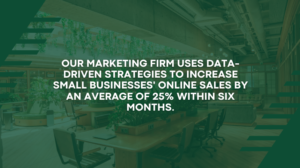
Example 5
- Original Bad Pitch: “We sell eco-friendly products.”
- Critique and Reasons for Ineffectiveness: This pitch is too generic and doesn’t specify the type of products or their benefits.
- Revised Pitch with Improvements: “GreenChoice offers a range of eco-friendly household cleaning products that are 100% biodegradable and safe for families and pets.”
- Explanation of Why the New Version is Better: The revised pitch specifies the product range, key benefits (100% biodegradable and safe), and target market (families and pet owners).
Example 6
- Original Bad Pitch: “We help startups grow.”
- Critique and Reasons for Ineffectiveness: This pitch is very vague and doesn’t explain how they help startups grow or what makes their approach unique.
- Revised Pitch with Improvements: “Our accelerator program provides seed funding, mentorship, and a network of industry experts to help tech startups scale rapidly and successfully.”
- Explanation of Why the New Version is Better: The revised pitch outlines specific services (seed funding, mentorship, network), target market (tech startups), and the desired outcome (scale rapidly and successfully).
Example 7
- Original Bad Pitch: “We offer training programs.”
- Critique and Reasons for Ineffectiveness: This pitch lacks detail about the type of training, who it’s for, and the benefits it offers.
- Revised Pitch with Improvements: “SkillBoost provides specialized training programs for software developers, helping them master the latest technologies and increase their job market value.”
- Explanation of Why the New Version is Better: The revised pitch specifies the type of training (software development), target audience (software developers), and the benefit (increased job market value).
Example 8
- Original Bad Pitch: “We design websites.”
- Critique and Reasons for Ineffectiveness: This pitch is very basic and doesn’t explain what makes their web design services unique or effective.
- Revised Pitch with Improvements: “Our web design agency creates custom, mobile-responsive websites that enhance user experience and boost online conversions by up to 50%.”
- Explanation of Why the New Version is Better: The revised pitch specifies the service (custom, mobile-responsive websites), key benefit (enhanced user experience and conversions), and quantifies the improvement (up to 50%).

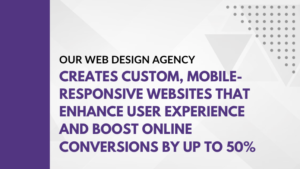
Example 9
- Original Bad Pitch: “We produce educational content.”
- Critique and Reasons for Ineffectiveness: This pitch is too broad and doesn’t explain the type of educational content or its impact.
- Revised Pitch with Improvements: “EduVantage produces interactive online courses for K-12 students, improving engagement and academic performance by incorporating gamified learning.”
- Explanation of Why the New Version is Better: The revised pitch specifies the content (interactive online courses), target audience (K-12 students), and unique approach (gamified learning), along with its benefits.
Example 10
- Original Bad Pitch: “We offer financial services.”
- Critique and Reasons for Ineffectiveness: This pitch is too vague and doesn’t explain what type of financial services are offered or the benefits to the customer.
- Revised Pitch with Improvements: “Our fintech startup provides AI-powered financial planning tools that help millennials save and invest more efficiently, achieving their financial goals faster.”
- Explanation of Why the New Version is Better: The revised pitch specifies the service (AI-powered financial planning tools), target market (millennials), and the benefits (saving and investing more efficiently).
Example 11
- Original Bad Pitch: “We sell organic food products.”
- Critique and Reasons for Ineffectiveness: This pitch is too broad and doesn’t highlight the specific benefits or unique selling points.
- Revised Pitch with Improvements: “OrganicHarvest delivers fresh, organic produce directly from local farms to your doorstep, ensuring you eat healthier while supporting sustainable agriculture.”
- Explanation of Why the New Version is Better: The revised pitch specifies the service (delivery of organic produce), benefits (healthier eating, supporting local farms), and the unique aspect (direct from local farms).
Example 12
- Original Bad Pitch: “We offer cloud storage solutions.”
- Critique and Reasons for Ineffectiveness: The pitch is generic and doesn’t explain what makes the cloud storage solutions different or better.
- Revised Pitch with Improvements: “CloudGuard provides ultra-secure, user-friendly cloud storage solutions with advanced encryption, ensuring your data is always safe and accessible.”
- Explanation of Why the New Version is Better: The revised pitch highlights specific features (ultra-secure, user-friendly, advanced encryption) and benefits (safety and accessibility).
Example 13
- Original Bad Pitch: “We have a fitness app.”
- Critique and Reasons for Ineffectiveness: This pitch is too vague and doesn’t explain the unique features or benefits of the app.
- Revised Pitch with Improvements: “FitLife is a personalized fitness app that uses AI to create custom workout plans and track your progress, helping you achieve your fitness goals faster.”
- Explanation of Why the New Version is Better: The revised pitch specifies the unique feature (AI-driven custom workout plans), benefits (personalization, progress tracking), and the goal (achieving fitness goals faster).
Example 14
- Original Bad Pitch: “We provide IT support services.”
- Critique and Reasons for Ineffectiveness: This pitch is too generic and doesn’t highlight any specific advantages or unique features.
- Revised Pitch with Improvements: “TechAssist offers 24/7 IT support with a dedicated team of experts, ensuring your business runs smoothly without any technical disruptions.”
- Explanation of Why the New Version is Better: The revised pitch emphasizes the key features (24/7 support, dedicated team of experts) and benefits (smooth business operations, no technical disruptions).
Example 15
- Original Bad Pitch: “We make eco-friendly packaging.”
- Critique and Reasons for Ineffectiveness: The pitch is vague and doesn’t specify the type of packaging or its benefits.
- Revised Pitch with Improvements: “EcoPack creates biodegradable packaging solutions that reduce waste and lower your carbon footprint, perfect for environmentally conscious businesses.”
- Explanation of Why the New Version is Better: The revised pitch specifies the type of packaging (biodegradable), benefits (reducing waste, lowering carbon footprint), and the target market (environmentally conscious businesses).
Example 16
- Original Bad Pitch: “We develop mobile games.”
- Critique and Reasons for Ineffectiveness: This pitch is too broad and doesn’t highlight what makes their mobile games unique.
- Revised Pitch with Improvements: “GameCraze designs immersive, story-driven mobile games that captivate players and keep them engaged for hours, setting new standards in mobile entertainment.”
- Explanation of Why the New Version is Better: The revised pitch specifies the unique features (immersive, story-driven), benefits (captivating, engaging), and the goal (setting new standards in mobile entertainment).
Example 17
- Original Bad Pitch: “We provide travel services.”
- Critique and Reasons for Ineffectiveness: This pitch is too generic and doesn’t explain what specific travel services are offered or their benefits.
- Revised Pitch with Improvements: “TravelEase offers customized travel planning and booking services, ensuring you have a stress-free and memorable vacation tailored to your preferences.”
- Explanation of Why the New Version is Better: The revised pitch specifies the services (customized travel planning and booking), benefits (stress-free, memorable vacation), and the unique aspect (tailored to preferences).
Example 18
- Original Bad Pitch: “We have an e-commerce platform.”
- Critique and Reasons for Ineffectiveness: The pitch is too vague and doesn’t highlight the platform’s unique features or benefits.
- Revised Pitch with Improvements: “ShopSmart is an AI-powered e-commerce platform that personalizes shopping experiences, increasing customer satisfaction and boosting sales for online retailers.”
- Explanation of Why the New Version is Better: The revised pitch specifies the unique feature (AI-powered personalization), benefits (increased customer satisfaction, boosted sales), and target market (online retailers).
Example 19
- Original Bad Pitch: “We offer legal services.”
- Critique and Reasons for Ineffectiveness: This pitch is too broad and doesn’t specify the type of legal services or their benefits.
- Revised Pitch with Improvements: “LegalEdge provides specialized legal services for startups, offering expert advice and support to navigate complex legal landscapes and ensure compliance.”
- Explanation of Why the New Version is Better: The revised pitch specifies the type of legal services (specialized for startups), benefits (expert advice, support, compliance), and the unique aspect (specialization).
Example 20
- Original Bad Pitch: “We provide financial advice.”
- Critique and Reasons for Ineffectiveness: The pitch is too generic and doesn’t highlight any specific advantages or unique features.
- Revised Pitch with Improvements: “WealthWise offers personalized financial planning and investment strategies, helping individuals achieve their financial goals with confidence and security.”
- Explanation of Why the New Version is Better: The revised pitch specifies the services (personalized financial planning and investment strategies), benefits (achieving financial goals, confidence, and security), and the target market (individuals).
Lessons Learned from These Transformations
- Specificity Matters: Clear and specific details about the problem, solution, and benefits make your pitch more compelling and easier to understand.
- Focus on the Unique Value Proposition: Highlighting what sets your business apart helps capture interest and differentiate you from competitors.
- Quantifiable Benefits: Using concrete numbers and outcomes can significantly enhance the credibility and attractiveness of your pitch.
- Clarity and Simplicity: Avoid jargon and complex language. Keep your pitch straightforward and easy to grasp.
- Targeted Messaging: Tailoring your pitch to a specific audience makes it more relevant and engaging.
Example 21
- Original Bad Pitch: “We create educational software.”
- Critique and Reasons for Ineffectiveness: This pitch is too generic and doesn’t specify what the software does or who it’s for.
- Revised Pitch with Improvements: “EduTech develops interactive learning software for high school students, enhancing engagement and improving academic performance through gamified educational content.”
- Explanation of Why the New Version is Better: The revised pitch specifies the target audience (high school students), unique feature (interactive, gamified content), and benefits (enhanced engagement, improved academic performance).
Example 22
- Original Bad Pitch: “We sell handmade jewelry.”
- Critique and Reasons for Ineffectiveness: This pitch is too vague and doesn’t highlight what makes the jewelry unique or desirable.
- Revised Pitch with Improvements: “ArtisanGems offers handcrafted jewelry made from ethically sourced materials, providing customers with unique, eco-friendly pieces that make a statement.”
- Explanation of Why the New Version is Better: The revised pitch specifies the unique selling points (handcrafted, ethically sourced materials), benefits (unique, eco-friendly), and target audience (customers who value ethical products).
By examining these examples and understanding the improvements made, you can apply these lessons to refine your own elevator pitch.
Focus on clarity, specificity, and the unique value you bring to your market, and you’ll be well on your way to crafting a pitch that resonates with investors and stakeholders.
16 Tips for Crafting a Compelling Elevator Pitch
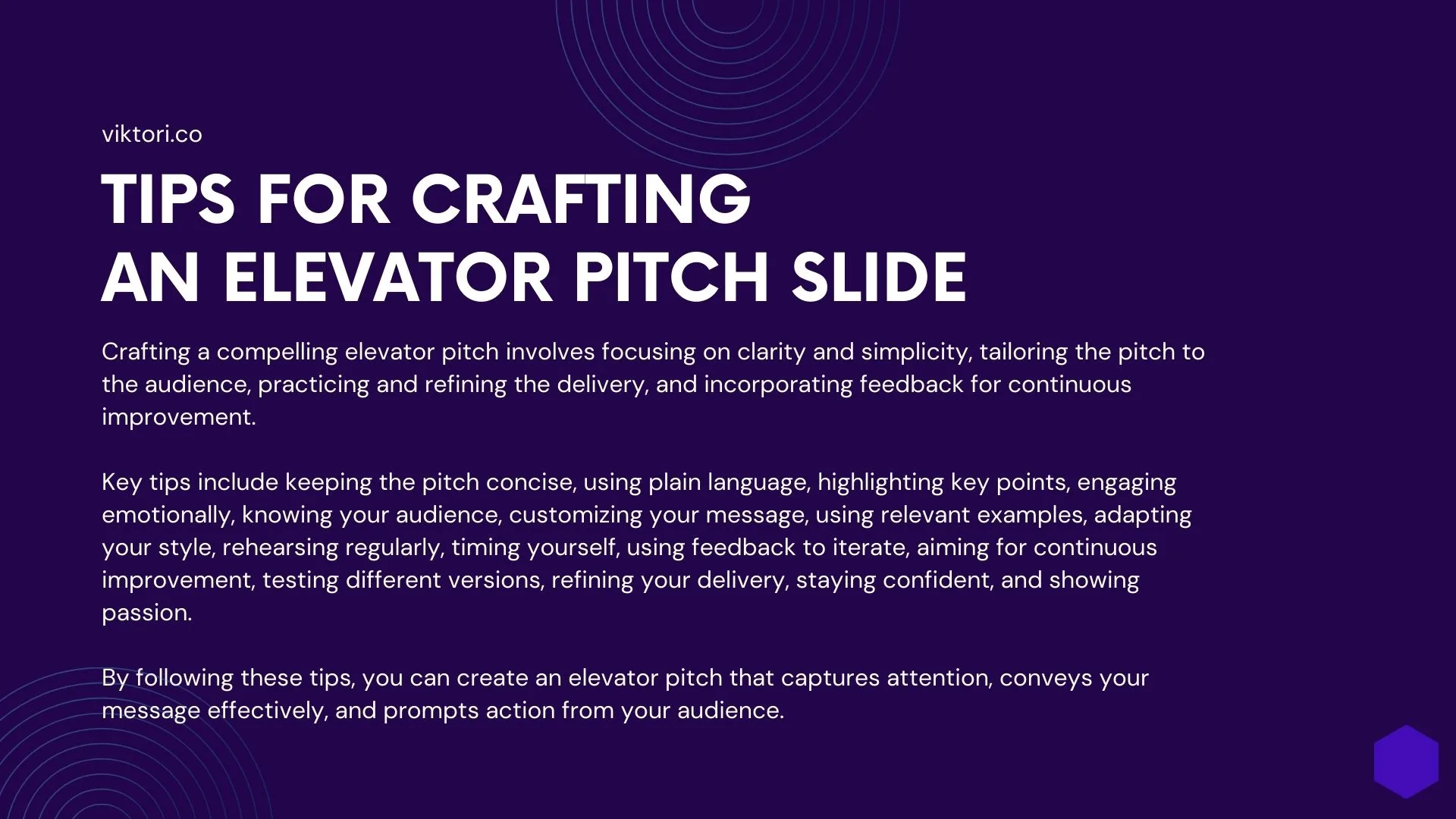
Crafting a compelling elevator pitch is both an art and a science. Here are some essential tips to help you create a pitch that captivates and persuades your audience:
Focus on Clarity and Simplicity
- Be Concise: An effective elevator pitch should be no longer than 3-6 seconds. This time frame forces you to distill your message to its essence. Avoid unnecessary details and focus on the core aspects of your business idea.
- Use Plain Language: Avoid jargon, acronyms, and technical terms that may confuse your audience. Use simple and clear language that everyone can understand. The goal is to ensure your message is accessible to a broad audience, regardless of their familiarity with your industry.
- Highlight Key Points: Clearly outline the problem, your solution, the unique value proposition, and the target market. Each of these elements should be presented in a straightforward manner, ensuring the audience can easily follow your narrative.
- Engage Emotionally: While being clear and simple, try to connect emotionally with your audience. Use a compelling opening line or an engaging anecdote to draw them in and make your pitch memorable.
Tailor the Pitch to the Audience
- Know Your Audience: Understand who you are pitching to and what matters most to them. Whether it’s potential investors, customers, or partners, tailor your pitch to address their specific interests and concerns.
- Customize Your Message: Modify your pitch based on the audience’s knowledge and needs. For instance, an investor pitch might focus more on financial projections and market potential, while a customer pitch might emphasize the benefits and features of the product.
- Use Relevant Examples: Incorporate examples or case studies that resonate with your audience. If you’re pitching to a tech-savvy audience, highlight technological aspects; if it’s a consumer group, focus on user experience and benefits.
- Adapt Your Style: Adjust your tone and delivery style to match the preferences of your audience. A more formal tone might be suitable for corporate investors, while a conversational style could work better for a creative industry audience.
Practice and Refine Your Pitch
- Rehearse Regularly: Practice your pitch until it becomes second nature. Rehearse in front of a mirror, record yourself, or present to friends and family. Regular practice helps you deliver your pitch confidently and smoothly.
- Time Yourself: Ensure your pitch fits within the 3-6 second timeframe. Practice with a timer to refine your delivery and make sure you stay within the limit without rushing.
- Use Feedback for Improvement: Present your pitch to a small, trusted audience and ask for their honest feedback. Pay attention to their reactions and suggestions for improvement.
- Refine Your Delivery: Work on your delivery style, including your tone, pace, and body language. Aim to be enthusiastic and engaging, as your passion can significantly influence how your pitch is received.
Incorporate Feedback and Iterate
- Gather Constructive Feedback: Seek feedback from multiple sources, including mentors, colleagues, and industry experts. Constructive criticism can provide valuable insights into areas that need improvement.
- Analyze and Iterate: Carefully analyze the feedback you receive and identify common themes or recurring suggestions. Use this information to make informed adjustments to your pitch.
- Continuous Improvement: Treat your elevator pitch as a living document that evolves over time. Regularly revisit and refine it based on new insights, market changes, or feedback.
- Test Different Versions: Experiment with different versions of your pitch to see which one resonates best with your audience. A/B testing can help you identify the most effective elements of your pitch.
By focusing on clarity and simplicity, tailoring your message to the audience, practicing rigorously, and continuously incorporating feedback, you can craft an elevator pitch that not only captures attention but also persuades and inspires your audience. This approach ensures your pitch remains relevant, engaging, and effective in various contexts.
Recap of the Importance of a Well-Crafted Elevator Pitch Slide
A well-crafted elevator pitch slide is more than just a summary of your business idea; it’s the gateway to engaging potential investors, partners, and stakeholders. It sets the tone for your entire pitch deck, establishes credibility, and sparks interest in your venture. By clearly articulating the problem, presenting a compelling solution, and highlighting your unique value proposition, you can make a strong first impression that resonates with your audience and paves the way for deeper discussions.
References
Books, Articles, and Resources on Elevator Pitches and Pitch Decks
- Books:
- “Pitch Anything: An Innovative Method for Presenting, Persuading, and Winning the Deal” by Oren Klaff
- “The Art of the Pitch: Persuasion and Presentation Skills that Win Business” by Peter Coughter
- “HBR Guide to Persuasive Presentations” by Nancy Duarte
- Online Resources:
If you want to really dive into the world of pitch decks, check out our complete collection of pitch deck guides, pitch deck outlines and pitch deck examples. Got a pressing issue? Check out our forum and post your questions there.
By utilizing these resources, you can enhance your pitch deck and ensure your elevator pitch stands out. You got this!
But if you don’t got it:
Join hundreds of successful entrepreneurs who’ve transformed their pitch decks with my help.
Let me develop an investor ready deck by using my hands-off approach, which includes: market research, copy, design, financials, narrative and strategy.
One week turnaround time.
The least you will get is 10 actionable tips & strategies to own that next presentation, worth $599, for free.

